| [1] Sharma H,Sibinski M,Sherlock DA.Outcome of lateral humeral condylar mass fractures in children associated with elbow dislocation or olecranon fracture.Int Orthop.2009; 33(2):509-514.[2] 邓志强,刘昕,叶家军.空心螺钉及克氏针治疗儿童肱骨外髁骨折[J].实用骨科杂志,2016,22(5):442-444. [3] 牛晓锋,査国庆,陈顺华.切开复位和克氏针内固定治疗儿童不稳定肱骨外髁骨折[J].中国骨与关节损伤杂志, 2016,31(6):32-33. [4] Marcheix PS,Vacquerie V,Longis B,et al.Distal humerus lateral condyle fracture in children: when is the conservative treatment a valid option.Orthop Traumatol Surg Res.2011; 97(3):304-307. [5] Leonidou A,Chettiar K,Graham S,et al.Open reduction internal fixation of lateral humeral condyle fractures in children. A series of 105 fractures from a single institution. Strategies Trauma Limb Reconstr.2014;9(2):73-78. [6] 王浩,刘智.儿童肱骨外髁骨折治疗现状[J].实用骨科杂志, 2015, 21(9):817-821.[7] 唐青松,李明,刘星,等.暴露与埋藏克氏针内固定治疗儿童肱骨外髁骨折的Meta分析[J].中华创伤杂志, 2016,32(7):615-620.[8] Das De S,Bar D,Saters PM.Displaced humeral lateral condyle fracture in children: should we bury the pins?J Pediatr Orthop. 2012;32(6):573-578.[9] 徐大鹏,戴进,王晓东.可吸收骨棒治疗儿童肱骨外髁骨折[J].泸州医学院学报,2013,36(2):161-163.[10] Stang A.Critical evaluation of the Newcastle-Ottawa scale for the assessment of the quality of nonrandomized studies in meta-analyses.Eur J Epidemiol.2010;25(9):603-605. [11] 陈星光,刘珏,王晓东,等.两种术式治疗儿童桡骨颈骨折疗效的Meta分析[J].中华小儿外科杂志,2017, 38(5):349-355. [12] 周俊文,马翔,翟所迪.如何认识和解读Meta分析[J].兰州大学学报(医学版),2016,42(1):36-41. [13] 陆敏华.可吸收骨棒在儿童肱骨外髁骨折中的应用分析[D].苏州:苏州大学, 2017. [14] 鄂兵,于晓龙,王忠良.克氏针及可吸收螺钉治疗儿童陈旧性肱骨外髁骨折疗效分析[J].现代医药卫生,2015, 31(20):3132-3145. [15] 李谋林,何爱咏,李欣.切开内固定治疗儿童肱骨外髁陈旧性骨折[J].中国现代手术学杂志,2007,11(4): 308-310.[16] 张剑坤.两种内固定材料在儿童肱骨外髁骨折手术中的疗效分析[D].重庆:重庆医科大学,2014.[17] 张路,覃佳强,李明,等.可吸收螺钉治疗儿童肱骨外髁骨折40例[J].临床小儿外科杂志,2008,7(2):15-17.[18] 宿玉玺,谢艳,覃佳强,等.可吸收螺钉治疗儿童肱骨外髁骨折中期疗效分析[J].第三军医大学学报,2015, 37(3):234-237.[19] 李奕标,蔡瑞歆,程培楷,等.克氏针及可吸收螺钉治疗儿童肱骨外髁骨折的疗效及应用价值观察[J].山西医院杂志, 2016,45(6): 652-654.[20] Tejwani N,Phillips D,Goldstein RY.Management of lateral humeral condylar fracture in children. J Am Acad Orthop Surg. 2011;19(6):350-358.[21] Flynn JC,Matthews JG,Benoit RL.Blind pinning of displaced supracondylar fractures of the humerus in children. Sixteen years' experience with long-term follow-up.J Bone Joint Surg Am.1974;56(2):263-272.[22] 于晓龙,王忠良.儿童肱骨外髁骨折的相关研究进展[J].现代医药卫生, 2015,31(13):1981-1984.[23] Broberg MA,Morrey BF.Results of delayed excision of the radial head after fracture.J Bone Joint Surg Am. 1986;58(5): 669-674.[24] Milch H.Fractures and fracture dislocations of the humeral condyles.J Trauma.1964;4(5):592-607.[25] 陈姬,蔡静怡,王苏明,等.肘关节斜位片在儿童轻度肱骨外髁骨折中的应用[J].西部医学,2015,27(8):1212-1214.[26] Jakob R,Fowles JV,Rang M,et al.Observations concerning fractures of the lateral humeral condyle in children.J Bone Joint Surg(Br). 1975;57(4):430-436. [27] Weiss JM,Graves S,Yang S,et al.A new classification system predictive of complications in surgically treated pediatric humeral lateral condyle fractures.J Pediatr Orthop.2009; 29(6):602-605. [28] Finnbogason T,Karlsson G,Lindberg L,et al.Nondisplaced and minimally displaced fractures of the lateral humeral condyle in children: a prospective radiographic investigation of fracture stability.J Pediatr Orthop.1995;15(4):422-425. ?[29] 刘尧,王晓东.小儿轻度移位Jakob II型肱骨外髁骨折治疗方法研究[J].中国全科医学,2014,17(24): 2864-2867. [30] 于晓龙.儿童陈旧性肱骨外髁骨折的预防和治疗研究[J].重庆:重庆医科大学,2015. [31] 迮仁浩,李进,梅海波,等.儿童移位≤2 mm肱骨外髁骨折手术与保守治疗的多中心回顾性研究[J].中华小儿外科杂志, 2016, 37(12):909-912.[32] 周庆和,刘远忠,陈伟东.不同类型儿童肱骨外髁骨折的疗效分析及并发症[J].广东医学,2017,38(增刊):128-130.[33] 巴音桑,王晓东,袁泉文,等.可吸收固定棒治疗儿童髂骨撕脱性骨折[J].临床小儿外科杂志,2014,13(6): 548-549.[34] Foster DE,Sullivan JA,Gross RH.Lateral humeral condylar fractures in children.J Pediatr Orthop. 1985,5(1):16-22.[35] 贾国强,刘天婧,代琦,等.切开复位钢针固定治疗儿童早期陈旧性肱骨外髁骨折的中短期疗效评价[J].国际儿科学杂志, 2017, 44(5):366-368.[36] Koh KH,Seo SW,Kim KM,et al.Clinical and radio- graphic results of lateral condylar fracture of distal humerus in children. J Pediatr Orthop.2010;30(5):425-429. [37] Kocak T,Gebhard F,Keppler P.Non-union of pediatric lateral humeral condyle following post-traumatic cubitus valgus.Der Unfallchirurg. 2011;114(4):360-365.[38] 邓纯博,刘学勇,阿良,等.跗骨窦入路与外侧入路治疗成人跟骨关节内移位骨折的meta分析[J].中国医科大学学报, 2016,45(9): 818-823.[39] 邱皓,卢旻鹏,栾富钧,等.钢板内固定和髓内固定修复锁骨骨折的Meta分析[J].中国组织工程研究,2016,20(22):3337-3344.[40] 李雪迎.Meta分析研究报告解读中值得注意的几个问题[J].中国介入心脏病学杂志,2016,24(10):551.[41] 刘凯,尚如国,肖彦,等.手术治疗儿童陈旧性肱骨外髁骨折14例[J].中国骨伤,2017,30(1):83-85. |
.jpg)
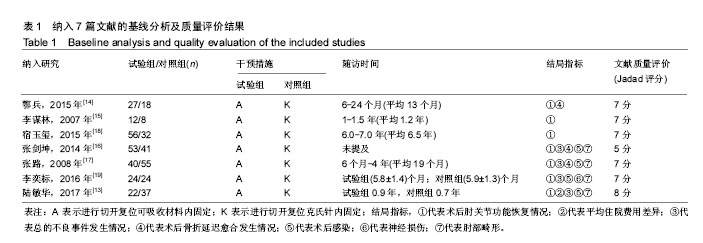
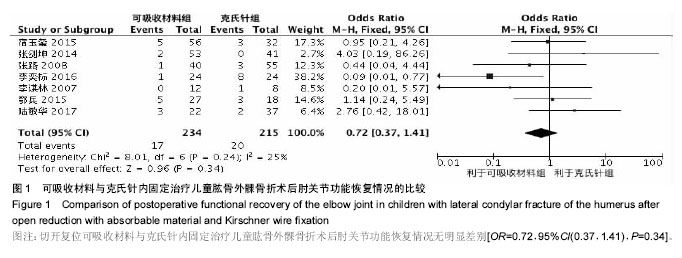

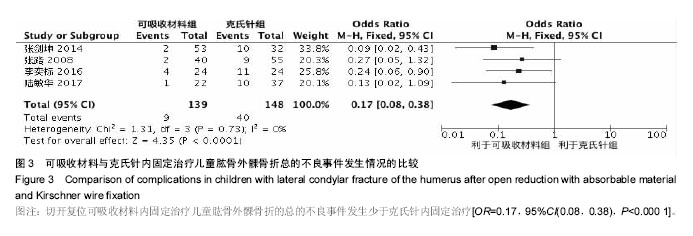
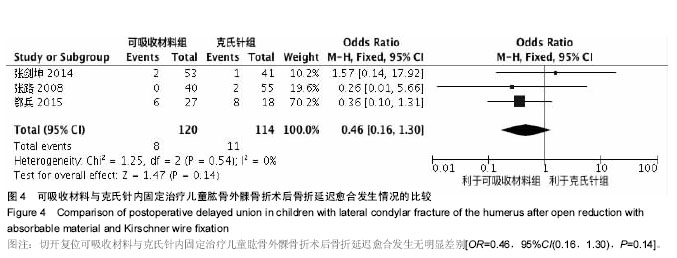
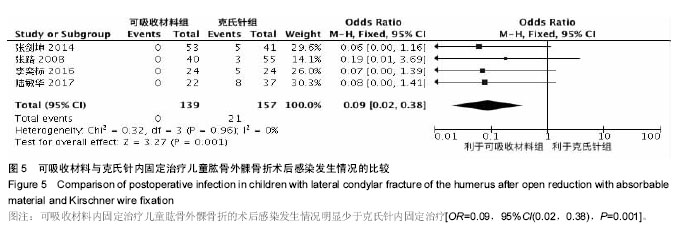

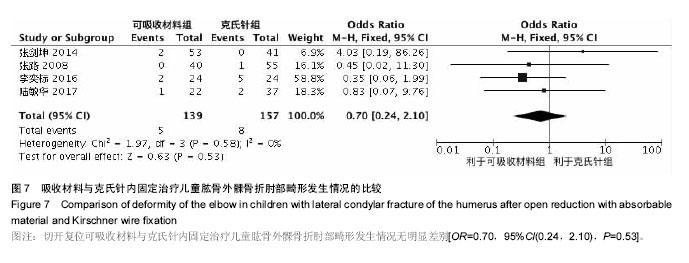
.jpg)